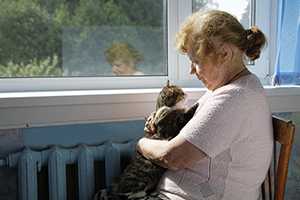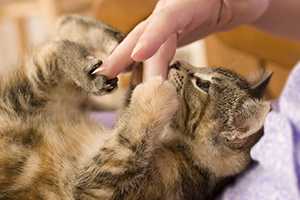Cats
Credit: CDC thanks Dr. Craig Datz, a veterinarian at Royal Canin, for his careful review of these pages.
Research has shown that cats provide emotional support, improve moods, and contribute to the overall morale of  their owners. Cats make great companions and are credited with promoting socialization among the elderly and physically or mentally disabled people. Estimates show nearly 40 million households in the United States have pet cats.
their owners. Cats make great companions and are credited with promoting socialization among the elderly and physically or mentally disabled people. Estimates show nearly 40 million households in the United States have pet cats.
Although cats rarely carry germs that make people sick, cat owners should be aware that this does happen. Germs from cats may cause a variety of illnesses in people, from minor skin infections to serious illnesses. With routine veterinary care and some simple health tips, you are less likely to get sick from touching, petting, or owning a cat. To protect yourself from getting sick:
- Seek routine veterinary care for your pet and
- Always wash your hands with running water and soap after contact with cats, their stool (poop), litter box, and their food.
The most common diseases associated with cats that can cause human illness are:
Campylobacteriosis (Campylobacter spp.)
Campylobacter is a type of bacteria that spreads through contaminated food (meat and eggs), water, or contact with stool (poop) of infected animals. Cats infected with Campylobacter may show no signs of illness at all or may have diarrhea.
Most people who become sick with campylobacteriosis will have diarrhea, cramping, abdominal pain, and fever within 2-5 days after exposure to the organism. Campylobacter bacteria can cause serious life-threatening infections in infants, older persons, and those with weakened immune systems.
Cat-scratch Disease (Bartonella henselae)
Cat-scratch disease is a bacterial disease that people may get after being bitten or scratched by a cat. About 40% of cats carry the bacteria at some time in their lives, although kittens younger than 1 year of age are more likely to have it. Most cats with this infection show no signs of illness.
People who are bitten or scratched by an affected cat may develop a mild infection 3-14 days later at the site of the wound. The infection may worsen and cause fever, headache, poor appetite, and exhaustion. Later, the person’s lymph nodes closest to the original scratch or bite can become swollen, tender, or painful. Seek medical attention if you believe you have cat-scratch disease.
Cheyletiellosis (Cheyletiella spp.)
Cheyletiellosis is a mild, short-term skin inflammation caused by mites that feed on skin cells. Cheyletiella is spread through contact with infested animals. Pets such as rabbits and adult cats may not show signs of infestation. However, affected kittens may have patches of scaly skin with dandruff.
The most common symptoms of cheyletiellosis in people include itching, redness, and raised bumps on areas of the skin that touched the infested animal. Cheyletiellosis in people generally resolves on its own.
(Note: CDC does not currently maintain information about cheyletiellosis; the link goes to a non-CDC resource.)
Cryptosporidiosis (Cryptosporidium spp.)
Cryptosporidiosis is a parasitic disease that is transmitted through contaminated food or water from an infected person or animal. Cryptosporidiosis in cats is rare, but they can carry the germ without showing any signs of illness.
Cryptosporidiosis can cause profuse, watery diarrhea with cramping, abdominal pain, and nausea in people and many types of animals. Illness in people is usually self-limiting and lasts only 2-4 days, but can become severe in people with weakened immune systems.
Echinococcosis (Echinococcus spp.)
Echinococcosis is a disease caused by eating or drinking food and water contaminated with tapeworm eggs or through contact with an infected animal. Cats become infected by eating tissue of an infected animal. Cats rarely show any signs of disease, but can be infected with a large number of adult tapeworms.
Although Echinococcus invades many different organs of the body, most people who are infected with the disease will not have any signs of illness for years. Symptoms start when the slow-growing cysts become large enough to press on the organs they have invaded. The tapeworms grow slowly in several different organs of the body, most commonly the liver and lungs.
Giardiasis (Giardia spp.)
Giardia is a parasite that causes diarrhea in animals and people. Giardia is transmitted to animals and people through food or water contaminated with stool.
Symptoms for animals and people include diarrhea, greasy stools, and dehydration. People can also have abdominal cramps, nausea, and vomiting. Symptoms can last 1-2 weeks.
Hookworm (Ancylostoma tubaeforme, Ancylostoma braziliense, Uncinaria stenocephala)
Cat hookworms are tiny worms that can spread through contact with contaminated soil or sand. Cats can also become infected with hookworms through accidentally ingesting the parasite from the environment or through their mother’s milk or colostrum. Hookworm infections can cause anemia and weight loss in kittens. Severe infections can be fatal.
People become infected with cat hookworms while walking barefoot, kneeling, or sitting on ground contaminated with stool (poop) of infected animals. Hookworm larvae enter the top layers of skin and cause an itchy reaction called cutaneous larva migrans. A red squiggly line may appear where the larvae have migrated under the skin. Symptoms usually resolve without medical treatment in 4-6 weeks.
MRSA (Methicillin-Resistant Staphylococcus aureus)
Staphylococcus aureus is a common type of bacteria that is normally found on the skin of people and animals. Methicillin-resistant Staphylococcus aureus (MRSA) is the same bacterium that has become resistant to some antibiotics. Cats and other animals often can carry MRSA without being sick, but MRSA can cause a variety of infections, including of the skin, respiratory tract, and urinary tract.
MRSA can be transmitted back and forth between people and animals through direct contact. In people, MRSA most often causes skin infections that can range from mild to severe. If left untreated, MRSA can spread to the bloodstream or lungs and cause life-threatening infections.
Pasteurellosis (Pasteurella spp.)
Pasteurellosis is a bacterial disease associated with animal bites and scratches. Pasteurella is a normal bacterium that lives in the mouths of healthy cats. The bacteria do not typically make cats sick; however, cats can develop abscesses or skin infections in places where they were scratched or bitten by another animal.
In people, pasteurellosis causes painful wound and skin infections. In severe cases, it can cause widespread infection and might even affect the nervous system.
(Note: CDC does not currently maintain information about cheyletiellosis; the link goes to a non-CDC resource.)
Plague (Yersinia pestis)
Plague is a bacterial disease in animals and people that can lead to serious illness or death if left untreated. Cats are highly susceptible to plague and their symptoms are similar to those experienced by humans. Cats that hunt wild rodents and rabbits in the western, particularly the southwestern, United States are at greatest risk of becoming infected.
People most often become infected through flea bites or from contact with body fluids of infected animals. Bubonic plague is the most common form; symptoms include sudden onset of high fever, chills, headache, malaise, and swollen lymph nodes. The other two forms of plague, septicemic and pneumonic, cause more severe disease. Cats infected with plague can infect people through bites, scratches, coughs, or sneezes.
Rabies
Rabies, a fatal neurologic disease in animals and people, is caused by a virus. Animals and people are most commonly infected through bites from rabid animals. Infected cats may have a variety of signs, but most often have sudden behavioral changes and progressive paralysis. Cats may also appear restless, pant, and attack other animals, people, or objects. Animals with rabies typically die within a few days of appearing sick. Owners should vaccinate their cats against this deadly disease.
The first symptoms in people can start days to months after exposure; they include generalized weakness, fever, and headache. Within a few days, symptoms progress to confusion, anxiety, and behavioral changes. If you have been bitten by a cat or other animal and feel that there is a risk for rabies, contact your health care provider right away. Once symptoms appear, it is almost always too late for treatment.
Ringworm (Microsporum canis)
Ringworm is a condition caused by a fungus that can infect skin, hair, and nails of both people and animals. Ringworm is passed from animals to people through direct contact with an infected animal's skin or hair. Cats infected with ringworm typically have small areas of hair loss around their ears, face, or legs, with scaly or crusty skin. But some cats carrying ringworm have no signs of infection at all. Kittens are most commonly affected.
Ringworm infections in people can appear on almost any area of the body. These infections are usually itchy. Redness, scaling, cracking of the skin, or a ring-shaped rash may occur. If the infection involves the scalp or beard, hair may fall out. Infected nails become discolored or thick and may possibly crumble.
Roundworm (Toxocara spp.)
Toxocara roundworms cause a parasitic disease known as toxocariasis. Cats and people can become infected by swallowing roundworm eggs from the environment. Cats can also become infected as young kittens. Larval worms can come through the milk of a mother cat, passing the infection on to her kittens. Infected kittens usually do not seem sick. Those that do may have mild diarrhea, dehydration, rough coat, and a pot-bellied appearance.
In people, children are most often affected with roundworm. There are two forms of the disease in people: ocular larva migrans and visceral larva migrans. Ocular larva migrans happens when the larvae invade the retina (tissue in the eye) and cause inflammation, scarring, and possibly blindness. Visceral larva migrans occurs when the larvae invade parts of the body, such as the liver, lung, or central nervous system.
Salmonellosis (Salmonella spp.)
Salmonella spreads to people through contaminated food (eggs and meat) or contact with stool of certain animals, including cats. Cats can get salmonellosis through eating infected birds. While it usually does not make the cats sick, Salmonella infection can cause serious illness when it is passed to people.
People infected with Salmonella bacteria may have diarrhea, vomiting, fever, or abdominal cramps. Infants, elderly persons, and those with weakened immune systems are more likely than others to develop severe illness.
Sporotrichosis (Sporothrix schenckii)
Sporotrichosis is a fungal disease that can affect both animals and people. It is usually acquired from the environment through a cut or scrape in the skin but can be acquired from contact with animals as well. Infection with sporotrichosis in cats can range from no signs of illness to very serious disease. Signs often begin with small draining wounds that become raised lumps with the surface eroded away. The disease can worsen.
Three forms of sporotrichosis can infect people.
- The first form is the cutaneous or skin form, which can progress from small raised areas on the skin to infection invading the lymph nodes and forming nodules that eventually ulcerate.
- The second is the disseminated form, which occurs when the infection affects the internal organs and bones.
- In the third form, the pulmonary form, a person acquires the infection through inhalation the fungus into the lungs, which often leads to chronic disease similar to tuberculosis.
The latter two forms are potentially fatal.
Toxoplasmosis (Toxoplasma gondii)
Toxoplasmosis is a parasitic disease that can spread to people and animals through contaminated soil, water, or meat, and contact with stool from an infected cat. Cats are the main source of infection to other animals but rarely appear sick.
Most healthy people who become infected with Toxoplasma show no signs or symptoms. However, pregnant women and people who have weakened immune systems may be at risk for serious health complications.
In this section
Healthy Habits
CDC recommends hand washing whenever you play or work with cats
-
Wash your hands with soap and running water after contact with cats, cat saliva or
 stool, and after cleaning a litter box. Thoroughly washing your hands will reduce the risk of disease transmission to people.
stool, and after cleaning a litter box. Thoroughly washing your hands will reduce the risk of disease transmission to people. - Wear gloves while gardening, particularly if you know that outdoor cats live in the area.
- Keep cats indoors, and prevent pet cats from interacting with stray animals.
- Train cats to use a litter box and keep litter boxes clean.
- Visit your veterinarian for routine evaluation and care to keep your cat healthy and to prevent infectious diseases.
- Be aware that even though a cat or kitten appears healthy, it may still spread diseases to people and animals.
Tips for preventing cat-associated diseases
Before choosing a cat
- Certain types of cat or kitten adoptions, like international pet adoption, may not be suitable for your family because of the risk for disease. This is particularly true if young children, pregnant women, or persons with weak immune systems are living in the household. Persons with weak immune systems may include the elderly or people with an illness such as diabetes or HIV/AIDS, or those undergoing chemotherapy.
- Research and learn how to properly care for your cat or kitten before purchase. Ask your veterinarian or pet store staff about the proper food, care, and enclosure or environment that is best for the cat or kitten you are selecting.
- Be aware that cats may shed Toxoplasma, Giardia, hookworms, roundworms and other germs in their stool (poop). Plan to clean up after your pet frequently. Wash your hands thoroughly with soap and water after feeding or cleaning up after cats.
Choosing a cat
- Match a cat’s personality and activity with your family, the animals you already have in your household, and the amount

of time you have to spend with your pet. - Pick a cat that is bright, alert, and playful. Cats and kittens should have shiny, soft fur that is free from stool (poop) and debris. Signs of sickness in a cat include appearing sluggish or depressed, having diarrhea, abnormal breathing, and fluid running from its eyes or nose. Make sure to take your new cat or kitten to the veterinarian within a few days to a week after adoption for a health visit.
- If your cat becomes sick or dies soon after purchase or adoption, take it to the veterinarian promptly, and inform the pet store, breeder, or rescue organization about the pet’s illness or death. Make sure to tell your veterinarian if the pet was adopted from a shelter or internationally.
Housing your cat
- It is important that you provide a safe, warm, and comfortable environment for your cat to live in.

- If your cat will live outside, provide shelter when it is cold or rainy and shade when it is hot. Protecting your cat from the changes in weather will reduce stress and help keep it healthy.
- Make sure your cat has access to food and fresh clean water every day.
- Be aware that leaving food outdoors for your cat may attract unwanted wildlife like raccoons and opossums.
- Always wash your hands after feeding your pets. Dry cat foods and jerky treats are occasionally contaminated with Salmonella bacteria.
Monitor your pet’s health
- Visit a veterinarian for routine evaluation and care to keep your cat healthy and prevent infectious diseases. Talk to your veterinarian about monthly preventive treatments for fleas, heartworms, and other parasites. Keep your pet flea- and tick-free and up-to-date on vaccinations to help prevent certain diseases.
- Make sure to clean up any urine, feces, or vomit in the house immediately, and disinfect the area well. Use disposable gloves and make sure to wash your hands thoroughly afterwards.
- Contact your veterinarian if you notice any signs of illness in your pet. Keep in mind that even cats that appear healthy can spread germs to people and other animals.
Cat bites and scratches
Preventing cat bites and scratches
Cat bites and scratches can be very serious even if they appear to be mild. Data on the number of people bitten or scratched by cats are limited because these incidents are not reported; however, 20%-80% of cat bites and scratches become infected. Cat-scratch disease or cat-scratch fever, an infection that causes fever and swollen lymph nodes, can develop from cat scratches even if they only break the surface of the skin. Based on reports of people treated for cat bites at hospitals, women are most likely to be victims of cat bites and scratches.
Follow these tips to prevent cat bites and scratches:
- Be cautious with unfamiliar animals. Approach cats with care, even if they seem friendly.

- Avoid rough play with cats and kittens. Rough play causes cats to be defensive toward people.
- Avoid rough play when animals are young so that it will lead to fewer scratches and bites as animals become older. Studies have shown cats generally bite when provoked.
- Trim cats’ nails frequently.
What to do if you are bitten or scratched by a cat
Germs can be spread from cat bites and scratches, even if the wound does not seem deep or serious. If you are bitten or scratched by a cat, you should:
- Wash wounds with warm soapy water immediately.
- Seek medical attention if:
- You don’t know if the cat has been vaccinated against rabies.
- The cat appears sick.
- The wound is serious.
- The wound becomes red, painful, warm or swollen.
- It has been more than 5 years since your last tetanus shot.
- Report the bite to animal control or your local health department if the bite is unprovoked and
- the cat is a stray or
- if you are unsure whether the cat has been vaccinated against rabies.
- Due to the risk of rabies, ensure that the cat is seen by a veterinarian and contact your local health department if it becomes sick or dies within 10 days of the bite.
Publications and materials
Brochures
Selecting a cat
American Veterinary Medical Association (AVMA)
Websites
Preventing ticks on your pets
CDC
Podcasts
People Can Catch Diseases from Their Pets
CDC
Helpful books and references
Cat-associated outbreaks
Schubach A, Schubach TMP, de Lima Barros MB, Wanke B. Cat-transmitted sporotrichosis, Rio de Janeiro, Brazil. Emerging Infectious Diseases [serial on the Internet]. 2005 Dec [Cited April 15, 2015].
Cat Scratch Disease in Children – Texas, September 2000 – August 2001. Morbidity and Mortality Weekly Report. 2002 Mar 15;51(10):212-4.
Public Health Response to a Rabid Kitten – Four States, 2007. Morbidity and Mortality Weekly Report. 2008 Jan 4;56(51):1337-40.
Update: Recall of Dry Dog and Cat Food Products Associated with Human Salmonella Schwarzengrund Infections — United States, 2008. Morbidity and Mortality Weekly Report. 2008 Nov 7;57(44):1200-2.
Research articles
Freshwater A. Why Your Housecat’s Trite Little Bite Could Cause You Quite a Fright: A Study of Domestic Felines on the Occurrence and Antibiotic Susceptibility of Pasteurella multocida. Zoonoses and Public Health. 2008 Oct;55(8-10):507-13.
Sanguinetti-Morelli D, Angelakis E, Richet H, Davoust B, Rolain JM, Raoult D. Seasonality of cat-scratch disease, France, 1999–2009. Emerging Infectious Diseases [serial on the Internet]. 2011 April [cited April 16, 2015].
O’Neil ME, Mack KA, Gilchrist J. Epidemiology of Non-Canine Bite and Sting Injuries Treated in the U.S. Emergency Departments, 2001-2004. Public Health Reports. 2007 Nov-Dec;122(6):764-75.
Patrick GR, O ’Rourke KM. Dog and cat bites: Epidemiologic Analyses Suggest Different Prevention Strategies . Public Health Report. 1998 May-Jun;113(3):252-7.
Additional information
Around the house pet tips. [PDF-2 pages]
Easy pet tips for kids. From CDC BAM
Chomel BB, Sun B. Zoonoses in the bedroom. Emerging Infectious [serial on the Internet]. 2011 Feb [Cited april 16, 2015].
Guptill L. Feline Bartonellosis. The Veterinary Clinics of North America. Small Animal Practice. 2010 Nov;40(6):1073-90.
Preventing Congenital Toxoplasmosis. Morbidity and Mortality Weekly Report: Recommendations and Reports. March 31, 2000 / 49(RR02);57-75.
Welsh R. Sporotrichosis. Journal of the American Veterinary Medical Association. 2003 Oct 15;223(8):1123-6.
- Page last reviewed: May 13, 2016
- Page last updated: May 13, 2016
- Content source:


 ShareCompartir
ShareCompartir